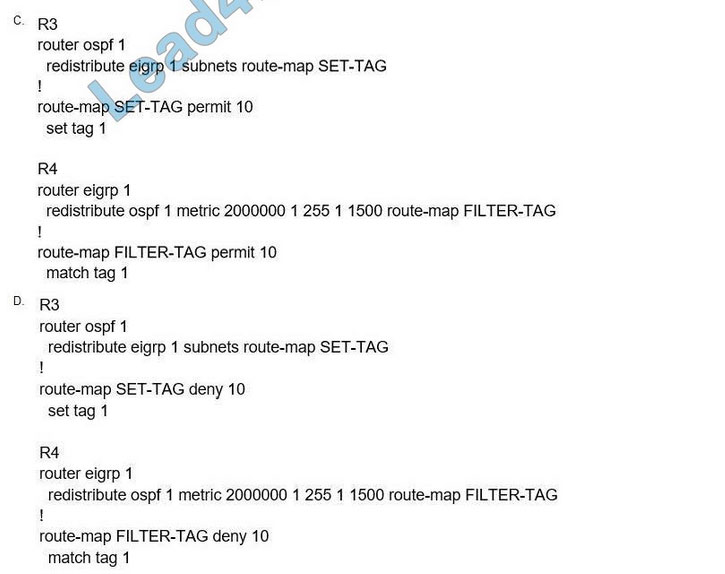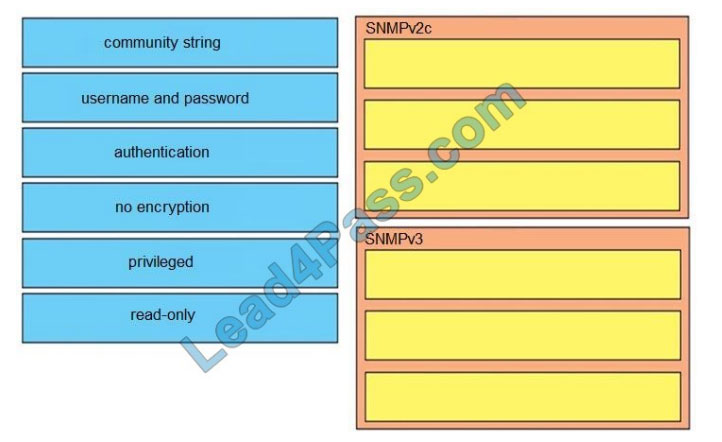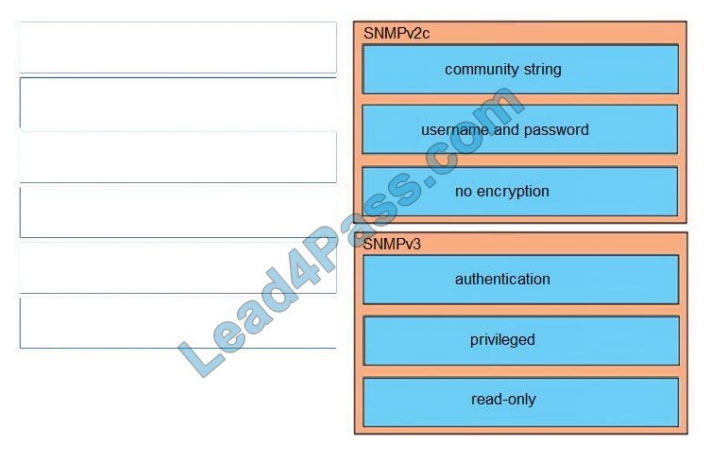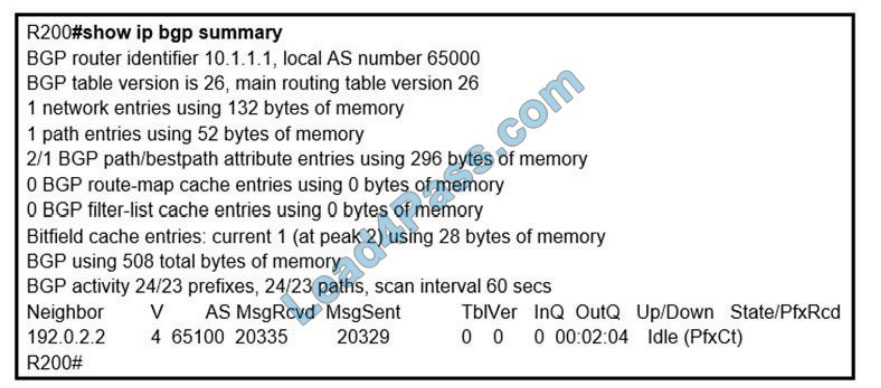The newly updated leads4pass 300-410 exam dumps contain 608 exam questions and answers, and candidates can take the Cisco 300-410 ENARSI exam in September and beyond, guaranteeing a successful first attempt.
Welcome to download the latest 300-410 exam dumps: https://www.leads4pass.com/300-410.html, with PDF files and VCE exam engine to help you study all exam questions easily.
PS.
leads4pass 300-410 dumps PDF example image:

leads4pass 300-410 dumps VCE example image:



You can verify the latest 300-410 dumps exam questions online:
New Question 1:
Refer to the exhibit. Users in the branch network of 2001:db8:0:4::/64 report that they cannot access the Internet. Which command is issued in IPv6 router EIGRP 100 configuration mode to solve this issue?

A. Issue the eigrp stub command on R1.
B. Issue the no eigrp stub command on R1.
C. Issue the eigrp stub command on R2.
D. Issue the no eigrp stub command on R2.
New Question 2:
Refer to the exhibit. Which configuration configures a policy on R1 to forward any traffic that is sourced from the 192.168.130.0/24 network to R2?

A. access-list 1 permit 192.168.130.0 0.0.0.255 ! interface Gi0/2 IP policy route-map test! route-map test permit 10 match IP address 1 set IP next-hop 172.20.20.2
B. access-list 1 permit 192.168.130.0 0.0.0.255 ! interface Gi0/1 IP policy route-map test! route-map test permit 10 match IP address 1 set IP next-hop 172.20.40.2
C. access-list 1 permit 192.168.130.0 0.0.0.255 ! interface Gi0/2 IP policy route-map test! r oute-map test permit 10 match IP address 1 set IP next-hop 172.20.20.1
D. access-list 1 permit 192.168.130.0 0.0.0.255 ! interface Gi0/1 IP policy route-map test! route-map test permit 10 match IP address 1 set IP next-hop 172.20.40.1
E. access-list 1 permit 192.168.130.0 0.0.0.255 ! interface Gi0/1 IP policy route-map test! route-map test permit 10 match IP address 1 set IP next-hop 172.20.20.1
New Question 3:
R2 has a locally originated prefix 192.168.130.0/24 and has these configurations: What is the result when the route-map OUT command is applied toward an eBGP neighbor R1 (1.1.1.1) by using the neighbor 1.1.1.1 route-map OUT out command?

A. R1 sees 192.168.130.0/24 as two AS hops away instead of one AS hop away.
B. R1 does not accept any routes other than 192.168.130.0/24
C. R1 does not forward traffic that is destined for 192.168.30.0/24
D. Network 192.168.130.0/24 is not allowed in the R1 table
New Question 4:
Which method changes the forwarding decision that a router makes without first changing the routing table or influencing the IP data plane?
A. nonbroadcast multiaccess
B. packet switching
C. policy-based routing
D. forwarding information base
New Question 5:
Refer to the exhibit. The output of the traceroute from R5 shows a loop in the network. Which configuration prevents this loop?



A. Option A
B. Option B
C. Option C
D. Option D
New Question 6:
Refer to the exhibit. An engineer configures a static route on a router, but when the engineer checks the route to the destination, a different next hop is chosen. What is the reason for this?

A. Dynamic routing protocols always have priority over static routes.
B. The metric of the OSPF route is lower than the metric of the static route.
C. The configured AD for the static route is higher than the AD of OSPF.
D. The syntax of the static route is not valid, so the route is not considered.
New Question 7:
Refer to the exhibit. An engineer is trying to generate a summary route in OSPF for network 10.0.0.0/8, but the summary route does not show up in the routing table. Why is the summary route missing?

A. The summary-address command is used only for summarizing prefixes between areas.
B. The summary route is visible only in the OSPF database, not in the routing table.
C. There is no route for a subnet inside 10.0.0.0/8, so the summary route is not generated.
D. The summary route is not visible on this router, but it is visible on other OSPF routers in the same area.
New Question 8:
Refer to the exhibit. An engineer is trying to block the route to 192.168.2.2 from the routing table by using the configuration that is shown.
The route is still present in the routing table as an OSPF route. Which action blocks the route?

A. Use an extended access list instead of a standard access list.
B. Change sequence 10 in the route-map command from permit to deny.
C. Use a prefix list instead of an access list in the route map.
D. Add this statement to the route map: route-map RM-OSPF-DL deny 20.
New Question 9:
What is a prerequisite for configuring BFD?
A. Jumbo frame support must be configured on the router that is using BFD.
B. All routers in the path between two BFD endpoints must have BFD enabled.
C. Cisco Express Forwarding must be enabled on all participating BFD endpoints.
D. To use BFD with BGP, the timers 3 9 command must first be configured in the BGP routing process.
New Question 10:
Refer to the exhibit. R2 is a route reflector, and R1 and R3 are route reflector clients. The route reflector learns the route to 172.16.25.0/24 from R1, but it does not advertise to R3. What is the reason the route is not advertised?

A. R2 does not have a route to the next hop, so R2 does not advertise the prefix to other clients.
B. Route reflector setup requires full IBGP mesh between the routers.
C. In route reflector setup, only classful prefixes are advertised to other clients.
D. In route reflector setups, prefixes are not advertised from one client to another.
New Question 11:

Refer to the exhibit. An engineer is trying to redistribute OSPF to BGP, but not all of the routes are redistributed. What is the reason for this issue?
A. By default, only internal routes and external type 1 routes are redistributed into BGP
B. Only classful networks are redistributed from OSPF to BGP
C. BGP convergence is slow, so the route will eventually be present in the BGP table
D. By default, only internal OSPF routes are redistributed into BGP
New Question 12:
Refer to the exhibit.

In which circumstance does the BGP neighbor remain in the idle condition?
A. if prefixes are not received from the BGP peer
B. if prefixes reach the maximum limit
C. if a prefix list is applied in the inbound direction
D. if prefixes exceed the maximum limit
New Question 13:
Which attribute eliminates LFAs that belong to protected paths in situations where links in a network are connected through a common fiber?
A. Shared Risk Link Group (SRLG)-disjoint
B. linecard-disjoint
C. lowest-repair-path-metric
D. interface-disjoint
New Question 14:
Refer to the exhibit.

An engineer is troubleshooting BGP on a device but discovers that the clock on the device does not correspond to the time stamp of the log entries. Which action ensures consistency between the two times?
A. Configure the service timestamps log uptime command in global configuration mode.
B. Configure the logging clock synchronize command in global configuration mode.
C. Configure the service timestamps log datetime localtime command in global configuration mode.
D. Make sure that the clock on the device is synchronized with an NTP server.
New Question 15:
Refer to the exhibit. What is the result of applying this configuration?

A. The router can form BGP neighborships with any other device.
B. The router cannot form BGP neighborships with any other device.
C. The router cannot form BGP neighborships with any device that is matched by the access list named “BGP”.
D. The router can form BGP neighborships with any device that is matched by the access list named “BGP”.
…
Publish the answer:
| Questions: | Answers: | Explain: |
| Q1 | B | |
| Q2 | E | |
| Q3 | A | |
| Q4 | C | |
| Q5 | A | |
| Q6 | C | The AD of the static route is manually configured to 130 which is higher than the AD of the OSPF router which is 110. |
| Q7 | C | The summary address is only used to create aggregate addresses for OSPF at an autonomous system boundary. It means this command should only be used on the ASBR when you are trying to summarize externally redistributed routes from another protocol domain or you have an NSSA area. But a requirement to create a summarized route is: The ASBR compares the summary route\’s range of addresses with all routes redistributed into OSPF on that ASBR to find any subordinate subnets (subnets that sit inside the summary route range). If at least one subordinate subnet exists, the ASBR advertises the summary route. |
| Q8 | B | |
| Q9 | C | |
| Q10 | A | |
| Q11 | D | If you configure the redistribution of OSPF into BGP without keywords, only OSPF intra-area and inter-area routes are redistributed into BGP, by default. You can redistribute both internal and external (type-1 and type-2) OSPF routes via this command: Router(config-router)#redistribute ospf 1 match internal external 1 external 2 |
| Q12 | D | |
| Q13 | A | |
| Q14 | C | The Time zone needs to be changed. default it UTC Central European Time (CET) |
| Q15 | C |
The Cisco 300-410 exam questions above are just to help you warm up. The 608 newly updated leads4pass 300-410 exam dumps have corrected previous questions and are guaranteed to work.
Download the latest 300-410 dumps now: https://www.leads4pass.com/300-410.html, with the always-active discount code “leads4pass2020” for a 12% discount.














